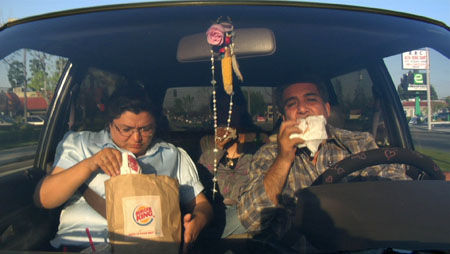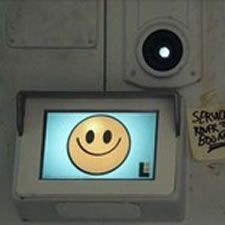 Luke and I have some thoughts to share on (500) Days of Summer, again published in SEE Magazine. The more this movie sits with me, the less I like it, to be honest. The best parts work very well in the moment, but the stuff that isn't so great is what stays with you. If I were still trying to be cutesy now, I would compare that to a bad relationship. And speaking of things that make you cringe, one thing that I didn't get a chance to mention in the piece is how much the very end (oh, say...the last three words) of this movie sucked. Anyone and everyone who wants to write, please never sacrifice the premise of your film/book/whatever to be cute. Duh. Read on:
Luke and I have some thoughts to share on (500) Days of Summer, again published in SEE Magazine. The more this movie sits with me, the less I like it, to be honest. The best parts work very well in the moment, but the stuff that isn't so great is what stays with you. If I were still trying to be cutesy now, I would compare that to a bad relationship. And speaking of things that make you cringe, one thing that I didn't get a chance to mention in the piece is how much the very end (oh, say...the last three words) of this movie sucked. Anyone and everyone who wants to write, please never sacrifice the premise of your film/book/whatever to be cute. Duh. Read on:
Clara: (500) Days of Summer, the latest twee romance from Fox Searchlight (
Garden State, Juno), chronicling a doomed relationship, is really targeted at twentysomethings like us. The content is a bit weighty for teenagers and the references just aren’t as pertinent to those who are older, though I’m sure it will have fans of all ages.
Luke: Right, and for here-and-now iconography, you could certainly do worse than Joseph Gordon-Levitt and Zooey Deschanel prancing through an Ikea. Even references to such things as The Pixies or The Smiths or, hell, even Ingmar Bergman come across less as throwbacks than as nods to contemporary hipster culture. Somehow, there’s something entirely 2009 about bonding over “There Is a Light That Never Goes Out” playing over an iPod in an elevator.
Clara: Yeah, and compared to, for example, Juno’s cultural touchstone, the hamburger phone — well, I didn’t know anyone who had a hamburger phone until they saw that movie. (500) Days doesn’t create a fantasy world or promote its own quirkiness; it carbon dates a culture I think we’ll recognize if we reflect back 20 years from now, and that’s rare and refreshing. The story, unfortunately, doesn’t work as well.
Luke: You’re right, sadly. We’re told the film — 500 asynchronous days of Gordon-Levitt’s Tom being in love with Deschanel’s commitment-phobic Summer — is “not a love story,” but the script fails to live up to this promise. “Happily ever after” is simply replaced with a forced personal growth narrative, weakening whatever the movie has to say about the inexplicable frustrations of relationships.
Clara: The movie often betrays its own premise, and it’s also tonally inconsistent. There are a bevy of stylistic flourishes, some good: the Bergman spoof is hilarious, and the scene that split-screens Tom’s expectations versus reality is quite effective at showing his idealization of his relationship. But other things are too much, like the whimsical narration, reminiscent of Lemony Snicket or Pushing Daisies. It pushes a movie that’s already busy over the edge. Further, an omniscient voice is just a lazy way to tell us that Tom’s ideas about love are based on a misreading of The Graduate. Worse is Tom’s precocious kid sister — enough with the all-knowing children, Hollywood!
Luke: We agree that Gordon-Levitt is great, though. From broodingly belting “Here Comes Your Man” with a karaoke mic in one hand and a beer in the other, to pontificating about pop culture and greeting cards as a generational crisis, he really has a lot to sell. This could have been a full-on disaster coming from someone lacking his skill.
Clara: That greeting card scene is full of clichés, but Gordon-Levitt plays it with believable sincerity. He pulls off a pretty emo character by tapping into adult angst without making him seem like a petulant teenager, and that’s a tricky balance. I’m becoming quite the fan, and his career as an adult actor is really progressing, from Brick to (500) Days to ... erm, G.I. Joe?
Luke: Whoo!
Clara: I like Deschanel too, but she’s disappointing here, though it’s not really her fault. The script is semi-autobiographical, and I get the impression that the writer never understood why the girl Summer is based on left him, and thus the character isn’t fully realized or three-dimensional. We’re seeing her from Tom’s perspective, but a woman afraid of commitment is an interesting role that would have been great to see Deschanel really tackle.
Luke: The ubiquity of the male-perspective can be frustrating (cue new Judd Apatow movie), but that criticism may be misplaced with (500) Days. Sure, Summer is, as The A.V. Club suggests, a sort of Manic Pixie Dream Girl, serving little function beyond invigorating the brooding male protagonist. But the film is very aware of this, playing off Deschanel’s persona to create a character largely presented to us as Tom’s naïve, Graduate-inspired fantasy.
Clara: Going back to your point about iconography, Deschanel’s most successful in the role of Zooey Deschanel: Object of Every Hipster’s Desire. That’s something the movie seems aware of.
Luke: She’s a clever meta-reference to herself in a film attacking expectations fueled by greeting cards and pop culture; what self-respecting indie kid doesn’t dream of dating Zooey Deschanel? But this just makes the film’s failings as an anti-love story all the more disappointing. The cultural criticisms ring hollow when everything goes to serve Tom’s personal narrative regardless.
Clara: Ironically, some viewers may wind up misreading the film just as Tom misreads The Graduate, and come away dreaming of a tumultuous affair with some hot, aloof chick like Zooey.
Luke: Hell, I know I am!
Clara: Of course.









